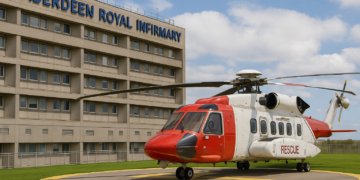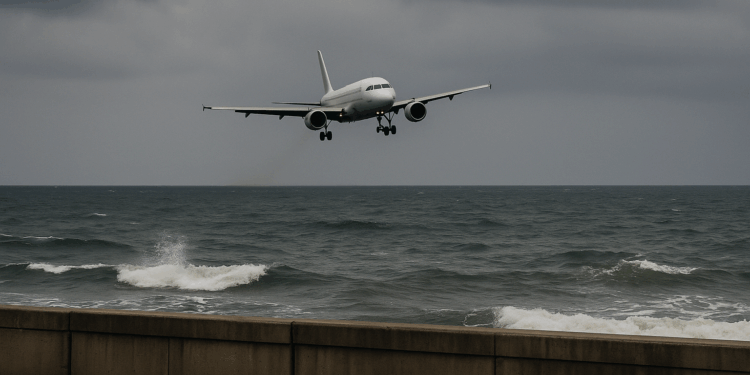Story Highlight
– Airbus A320 encountered serious incident after takeoff.
– Plane plunged towards sea at 300mph.
– Incident occurred shortly after departure from Catania.
– Immediate response required for potential disaster.
– Investigations launched to determine cause of incident.
Full Story
A serious incident involving an Airbus A320 aircraft occurred shortly after takeoff from Catania, Italy, when the plane reportedly plunged towards the sea at a speed of 300 miles per hour. This alarming event has raised significant concerns regarding aviation safety and has drawn the attention of both air traffic authorities and aviation experts.
Passengers aboard the flight were subjected to an unexpectedly perilous situation just moments after departing from the airport. Eyewitness accounts describe the moments leading up to the incident, with one traveller stating, “It felt like the ground was just disappearing beneath us.” The sense of panic amongst those on board was palpable, as the plane’s trajectory appeared to take a dangerous turn.
The aircraft, which is standard for commercial travel, promptly ascended before facing an unexpected drop. According to preliminary reports, the A320 encountered severe turbulence that may have contributed to the incident. Experts have noted that while turbulence is a common occurrence, the extreme nature of this situation raises questions about the aircraft’s operational integrity and the response protocols in place for crew members during such emergencies.
Emergency services were put on high alert following the incident, mobilising quickly as precautionary measures were implemented. The aircraft successfully regained control shortly after the alarming drop, allowing for a safe return to the Catania airport. No injuries were reported among the passengers or crew, which is a significant relief considering the potential severity of the situation.
A spokesperson for the airline emphasised their commitment to safety, stating, “The well-being of our passengers and crew is our utmost priority. We are currently investigating the circumstances surrounding this incident with the relevant authorities.” This commitment to transparency is vital, as it reassures the public that proper procedures will be upheld during the investigation process.
Investigators have already begun to seek answers, looking into both the aircraft’s maintenance records and the crew’s adherence to safety protocols. Further examination will focus on the aircraft’s performance data from the flight, which is critical for understanding the factors that led to the sudden descent. Additionally, the insights gathered from the cockpit voice and flight data recorders will play a crucial role in piecing together the events that unfolded.
Aviation experts have expressed the need for ongoing improvements in safety measures within the industry. Dr Sarah Mitchell, an aviation safety analyst, noted, “This incident underscores the importance of rigorous training and preparedness for flight crews, as well as advancements in aircraft technology that could prevent such alarming events in the future.” Her comments reflect a growing consensus among professionals regarding the necessity of ensuring that safety protocols evolve alongside changes in aviation technology.
Local authorities have been supportive throughout the incident, holding briefings to keep the public informed and emphasising the significance of cooperation with airline investigations. Community leaders have also offered their assistance, recognising the psychological toll such incidents can take on individuals who were aboard the flight.
The incident has captured media and public attention alike, prompting discussions not only about immediate safety concerns but also about broader implications for air travel. Social media platforms have seen an influx of reactions from users sharing their personal stories of air travel experiences, with many expressing both relief and anxiety over the incident.
As the investigation progresses, both the airline and regulatory authorities will be under intense scrutiny to ensure that all necessary measures are taken to prevent a recurrence of such incidents. The aviation community remains focused on understanding the complexities of this situation to enhance safety practices and maintain public confidence in air travel.
In conclusion, while the swift response from the flight crew played a critical role in averting disaster, the incident serves as a pertinent reminder about the unpredictability associated with aviation. As investigations unfold, the focus will remain on reinforcing the safety of air travel and ensuring the well-being of all who rely on this essential mode of transportation.























Terrifying incident. Glad there were no injuries, but this highlights the importance of rigorous maintenance regimes, clear crew communication and robust training for handling sudden control anomalies. Investigations should examine both technical causes and human factors so lessons can be applied across the industry to prevent recurrence. Continuous improvement in monitoring systems and emergency procedures is essential to maintain public confidence in air travel.
Terrifying incident. Glad everyone is safe but this underlines the need for thorough investigation and rapid action on any identified safety gaps. Review of crew procedures, maintenance records and flight data should be prioritised, and any lessons learned must be shared across operators to strengthen emergency preparedness and prevent recurrence.
Terrifying incident. Glad no one was hurt, but this highlights how critical strict maintenance and clear crew procedures are. Thorough investigation of the performance data and human factors is essential to prevent recurrence. We should also review training and emergency preparedness to ensure crews and cabin staff can respond effectively when seconds matter.
Disturbing incident. Glad everyone is safe but this highlights the importance of robust maintenance, thorough crew training and clear emergency procedures. Investigations should focus on mechanical systems, human factors and air traffic control interactions, and their findings must be used to update procedures and training promptly to prevent recurrence.